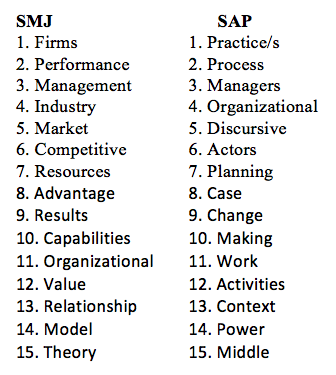Stephen Cummings (Victoria University Wellington) and Emmanuel Monod (Paris Dauphine University)
Vaara and Whittington’s 2012 Academy of Management Annals review paper of SAP research articles signifies a ‘coming of age’ that affords a new opportunity. As SAP has taken form, many articles have helped galvanize the fledgling field by outlining what SAP research is. Now we are able to report on what SAP research does. In preparation for a PDW at the 2012 AOM conference, “SAP in perspective”, we began to analyse the articles identified in Vaara and Whittington’s (VW’s) review.
While we don’t have space to reveal the concept maps we developed for the session here, the counts of the most common concepts in the abstracts of these papers and those they frequently cite provide a good list of what SAP researchers focussed on. The top 15 (excluding ‘strategy’) are: Practice/s; Process; Managers; Organizational; Discursive; Actors; Planning; Case; Change; Making; Work; Activities; Context; Power; Middle. When we looked at the abstracts of those papers not included in the VW list but cited 5 or more times by the VW articles, most of the same concepts showed up, but additional prominent concepts that might be added to a definitional list were: Social; Influence; Empirical; Systems and Decisions.
There was agreement at the PDW that this list captured what SAP was about. But what people have subsequently reported to be most useful was the SAP list contrasted with a set developed for a recent article in Long Range Planning – all article abstracts published in the Strategic Management Journal from 2001-2008. The two list of most common concepts shows SAP’s very distinct interests, compared with SMJ research:



